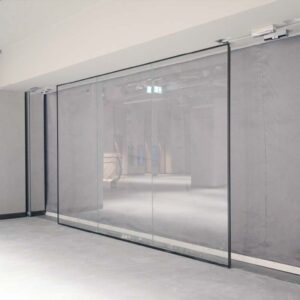Fire Curtains – Everything You Need to Know About Fire Curtains
Fire curtains are secret weapons when it comes to fire protection, hidden away in headboxes ready to be deployed in the event of a fire. They can play a key role in preventing the spread of a blaze, all while allowing modern building designs more flexibility. Interiors are able to include larger open plan areas without compromising on the building’s safety because fire curtains can be lowered to compartmentalise the space.
At CPFP, we know more than our fair share about fire safety. We’re experts in the installation and maintenance of passive fire protection, with a growing team of technicians fully qualified and accredited by the IFCC.
In this guide, we explain what fire curtains are and how they can help improve your building’s compliance with UK regulations.
What is a Fire Curtain?
Fire curtains are a form of active fire protection, meaning they respond to the presence of fire. Essentially, they are flexible fire barriers held out of sight until needed in a steel headbox on the ceiling, lobby, or doorway. They are made from a combination of fibreglass and metal wire, which enhances heat resistance and strength. A fire curtain that meets all the required regulations can withstand fire for up to 2 hours!
Active vs Passive Fire Protection – Everything You Need to Know >

What is the Purpose of a Fire Curtain?
Fire curtains are generally used in large open plan buildings where fire doors aren’t an option due to a lack of interior walls. They have three main purposes:
- Limit development of fire
- Prevent spread of fire and toxic smoke
- Protect escape routes
If you’re the responsible person for a large building or office, installing fire curtains can help you meet the required UK fire safety regulations even when your interior spaces make that tricky. Incorporating fire curtains into your building is just one of the many ways you can make your workplace safer for everyone.
More Fire Safety Tips for Workplaces >
Fire Curtain Regulations & Compliance
As with any fire protection, it needs to be compliant with the UK Regulatory Reform (Fire Safety) Order 2005. The BS 8524 standard provides guidance on the specification, installation, and maintenance of fire curtain barrier assemblies. Fire curtains are only granted compliance if they have been certified by a third party that holds a UKAS accreditation. This ensures that the fire curtain meets the right specification and can withstand fire for 2 hours, and advises that they are routinely tested after installation no less than once a month. Fire curtains are required to fulfil two main functions:
- Maintain compartmentation of buildings
- Allow access to escape routes without smoke entry or any loss of fire resistance
For fire protection that is fully certified by the IFCC, contact CPFP. We focus on passive fire protection, ensuring your building is compliant with the latest standards and building regulations.
See more: Passive Fire Protection Regulations, Standards and Accreditations
How Do Fire Curtains Work?
Fire curtains automatically drop between steel guide channels to seal off a space when triggered by fire alarm system. They also have a release mechanism which means gravity can take over if the motorised control fails. They then act as fire resistant barriers, dividing the building space into separate compartments.
This compartmentalisation restricts oxygen and fuel which can lower the intensity of fire and give other systems like sprinklers a chance to work, preserving important structural elements of the building for longer. Slowing the spread of fire also gives people valuable escape time which is vital in large multistorey buildings like apartment blocks and offices.
Fire Prevention & Safety Tips for Offices >
Benefits of Fire Curtains
Aside from the obvious lifesaving benefits, fire curtains can be implemented without affecting architecture or building design. They make larger open plan spaces possible, whilst still delivering the required level of fire protection, and can be used to protect wall openings like serving hatches. They won’t disrupt the appearance of the interior space either because they are stored discreetly in a headbox out of sight. As a result, fire curtains provide greater flexibility and freedom when it comes to designing a building.
Other Fire Stopping Products >
Passive Fire Protection in Bristol
Since 2014, we’ve been delivering exceptional standards of fire protection to our clients, as well as conducting remedial work to correct the work of others. From cavity barrier to penetration sealing and fire compounding, CPFP provide the full spectrum of passive fire protection, working closely on a wide range of projects to make sure all guidelines are met.
Get in touch with our team today and we can talk through our services and arrange a quotation.
Read more: Fire Door Regulations – Fire Door Regulations Explained
Read more: Structural Fire Protection – Structural Measures to Prevent the Spread of Fire
Speak to Us Today.
Address: The Old Angel, Flax Bourton, Bristol, BS48 3QQ
Phone: 0117 450 9943
Email: info@cpfp.co.uk
